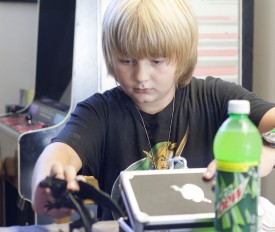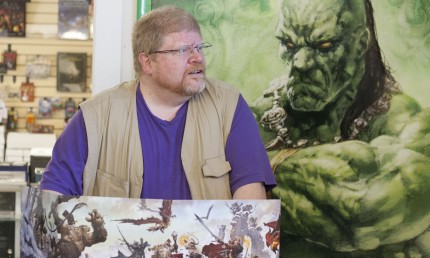Features Reporter
Here’s the situation: a group of mystical creatures band together in an unfamiliar town by the name of Baldur’s Gate. One of the companions, a warlock by the name of Demonsong, has been extorted by a thieving tax collector who has since gone into hiding in this unsuspecting city. The group’s mission is to track this criminal to his safehouse and deliver justice in any way necessary. The reward is bountiful, but the task is dangerous. Their success hangs on their individual skills, ability to work as a team and, perhaps most importantly, a fortunate roll of the dice. While this may sound like a Hollywood fantasy blockbuster, it does not take place in front of the camera, or even in a script.
It’s played out in the fantasy world of Dungeons and Dragons.
The notorious role-playing game has found a home here in Grand Junction and is gaining a strong following. The Jester’s Court, a shop located in Menagerie Square on 5th and Belford, has made its business buying and selling the Magic trading cards. It also hosts a weekly two-hour gathering for Dungeons and Dragons enthusiasts to come together and transform into a mythical character of their choosing and engage the fantasy world. D&D regular Justin Reid, who plays the character “Demonsong,” explained how getting many different personalities in the same room creates such a engaging atmosphere.
“It is a very social game, unlike common belief,” Reid said. “It is purely imaginative, and sometimes the scenarios can get pretty crazy because of that.”
The game begins with a user-created character, which can either be generated online or by hand with manuals that help players choose what attributes they can use within the rules of the game. Once all players have a character, the scene is set by the game’s narrator, known as the Dungeon Master. The Dungeon Master must be knowledgeable and creative, because it is their responsibility to control the scenario. They choose the setting in which the characters will be placed, the other fictitious people in that setting and plays the part of all characters that are not controlled by the other players. Once the conflict in the scenario is determined, the game is then passed on to the players for them to decide how to act.
The actions they take depend on the strengths and weaknesses of the characters they have generated and the seriousness of the situation. A goblin does not have a strong ability to inflict damage whereas a Dragonborn is a shoot-first-ask-questions-later kind of creature.
The most entertaining quality of D&D is its unpredictability. The same scenario can last several sessions without being completed, and if the same group were to play it again, it would end up being a completely different story. The more people who join the game, the more personalities enter the picture and create a stronger connection to the situation they are playing out. Dungeon Master Paul Scott related the game to writing a novel, but with more than one contributor.
“We work together to create a story,” Scott said. “But instead of a writer writing a book, a DM creates the world and lets the characters write the story.”
Any role-playing fanatics who would wish to join in on the action can visit The Jester’s Court on Wednesdays from 5 p.m. to 7 p.m. or connect with the members on their Facebook page, “Grand Junction Open D&D.”
mfreter@mavs.coloradomesa.edu


Recent Comments